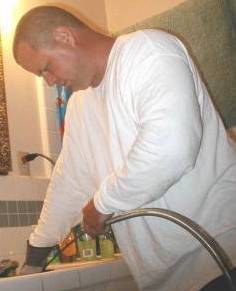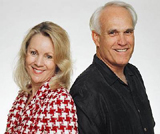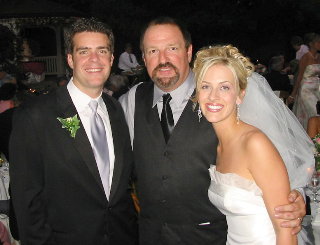|
News in Depth
AQMD Study Estimates Air in Much of LB Carries Higher Cancer Risk Than Refinery-Adjacent Areas; See Map Estimating Cancer Risk From Multiple Air Toxics
(April 21, 2002) -- A study completed last year by the South Coast Air Quality Management District (AQMD) estimates the air in much of LB carries a higher cancer risk from airborne toxics than most refinery-adjacent areas in L.A.'s southbay.
The study includes a map (posted on a link below) modeling the estimated cancer risks across the L.A. basin, including LB. It indicates that much of LB has a higher estimated cancer risk than other beach cities in L.A. and Orange County.
AQMD's study concluded that mobile sources -- including cars, trucks, trains, ships and aircraft -- are the greatest contributors to cancer risk. Roughly 70% of the airborne cancer risk was attributed to diesel particulate emissions. Roughly 20% came from other toxics associated with mobile sources (including benzene, butadiene, and formaldehyde) and about 10% came from stationary sources.
AQMD's estimate of L.A. basin airborne cancer risks was part of a landmark study of multiple air toxics, released last year, known as MATES-2 (Multiple Air Toxics Exposure Study). AQMD called the study "one of the most comprehensive conducted in an urban environment."
AQMD's study combined data from fixed locations as well as microscale mobile monitoring. One of the fixed sites was at 3648 N. Long Beach Blvd. (detail below)
The study combined the fixed site and mobile sites to produce the map of estimated cancer risks from multiple airborne toxics across the L.A. basin. It shows higher risk levels in the south-central Los Angeles area, in the harbor area, and near freeways.
Large parts of west, downtown and central LB are in the map's highest cancer chance category, a greater than 1,200 in a million (1.2 in a 1,000) chance of contracting cancer assuming the individual lives at the same site for 70 years. This area appears on the map as a computer generated black plume over freeway impacted parts of southeast L.A. County including western and downtown LB, Port areas and out to sea.
Most of ELB and part of LB's shore near the OC county line were ranked in a slightly lower cancer chance category akin to most of the L.A. basin urban area (estimated 1,000 to 1,200 in a million chance of contracting cancer if one lived at the site for 70 yrs.).
However, a portion of Los Altos south of 405 that appears to be in the area of LB Airport's main approach path is ranked in the map's highest risk area.
Most L.A. and O.C. beach areas had lower cancer risks than LB. According to the map, even most southbay refinery adjacent areas were estimated to have a lower cancer chance from airborne toxics than much of LB.
The study and the map arguably understate total health risks since they only indicate the risk of contracting cancer, not other diseases such as emphysema and COPD.
The Map modeling estimated cancer risk from all sources
The AQMD study includes a map is entitled, "Model Estimated Risk for the Basin (Numbers in a million, all sources)." We have provided two ways to view it.
The first link below should display the map on many computers but possibly not all. It's in a "png" format that AQMD used and apparently believes is commonly viewable. If it doesn't work for you, don't buy or download any special software. Just use our second, alternative method.
The second link will take you to all of Chapter 5 of the AQMD MATES-2 report in pdf form (roughly 331 kB, may take over a minute to download). Scroll to page 10 and increase the magnification (pull down menu, lower left corner of Adobe newsreader) to 200% and you'll see the map in considerable detail.
(We use the excellent pdf format for posting most documents on LBReport.com. So do many government sources. If you can't read pdf documents, we have included a link at the end of this article to download Adobe's free pdf document reader.)
AQMD MATES-2 model estimated cancer risk map (ES-5) (png format), click here.
AQMD MATES-2 model estimated cancer risk map (Figure 5-3a, page 5-10) (pdf format), go to page 10, increase magnification (pull down menu, lower left corner) to 200%, click here.
The Map modeling estimated cancer risk excluding diesel
The AQMD study also included a map (posted on link below) modeling the estimated cancer risk when diesel sources are excluded. Without diesel sources, much of LB fares better with risk levels resembling other L.A. and O.C. beach area levels.
However, about half the area north of the 405, including ELB and Bixby Knolls/Cal Hts. areas impacted by LB Airport, were modeled at higher cancer risk akin to inland L.A. areas. So were LB areas near the 91 freeway and the 710 freeway south of PCH (but not the Port).
The map excluding diesel risks showed the highest cancer risk levels in the area surrounding L.A. airport, roughly two to four times higher than what LB experiences now.
The map also shows elevated risk from non diesel sources in the general area of the 405 and 55 freeways near John Wayne Airport.
The map excluding diesel sources can be viewed in pdf form on page 11 of the MATES-2 report, scrolling to page 11, and increasing the magnification to 400%.
AQMD MATES-2 model estimated cancer risk map (Figure 5-3b, page 5-11) (pdf format), go to page 11, increase magnification to 400%, click here.
Chart comparing monitoring at LB fixed site vs. other fixed sites
A separate chart (linked below) indicates that within the category of the worst cancer risk (> 1,200 in a million), LB's fixed monitoring site (3648 N. Long Beach Blvd.) registered at the low end (i.e. the better end of the worst category), not as bad as L.A. This chart can be viewed in pdf form at:
Monitoring results at MATES-2 fixed sites (ES-2) (pdf format), click here.
Extended excerpts of the MATES-2 Executive Summary
We post extended excerpts of the AQMD MATES-2 Executive Summary below:
Mobile sources (e.g., cars, trucks, trains, ships, aircraft, etc.) represent the greatest contributor. About 70% of all risk is attributed to diesel particulate emissions; about 20% to other toxics associated with mobile sources (including benzene, butadiene, and formaldehyde); about 10% of all risk is attributed to stationary sources (which include industries and other certain businesses such as dry cleaners and chrome plating operations.)...
The sites with the greatest risk levels were in the south-central and east-central portions of Los Angeles County. At these locations, the dominance of mobile sources is even greater than at other sites...The differences in carcinogenic risk from one site to another are much more driven by the influence from mobile sources than from stationary sources...:
When 'carcinogenic risk' is discussed, it typically refers to the increased probability that an individual exposed to an average air concentration of a chemical will develop cancer when exposed over 70 years. Cancer risks are often expressed on a per-million basis for comparative purposes. As an example, a cancer risk of 100 in a million at a location means that the individuals staying at that location for 70 years have a 100 in a million chance of contracting cancer.
A "cancer burden" typically refers to the number of excess cancer cases expected in the exposed population. If 10,000 people live at that location, then the cancer burden for this population will be one (the population multiplied by the cancer risk). This means that one of the 10,000 people staying at the location for 70 years is estimated to
contract cancer.
...
The key results of the MATES-II study are as follows:
Fixed-Site (Regional) Program
A. Monitoring
- 1) The carcinogenic risk in the Basin is about 1,400 per million people. Mobile sources (e.g., cars, trucks, trains, ships, aircraft, etc.) represent the greatest contributor. About 70% of all risk is attributed to diesel particulate emissions; about 20% to other toxics associated with mobile sources (including benzene, butadiene, and formaldehyde); about 10% of all risk is attributed to stationary sources (which include industries and other certain businesses such as dry cleaners and chrome plating operations.) ...
- 2) The carcinogenic risk of 1,400 per million is based on a range from about 1,120 in a million to about 1,740 in a million among the ten sites. (See Figure ES-3, top)
- 3) The sites with the greatest risk levels were in the south-central and east-central portions of Los Angeles County. At these locations, the dominance of mobile sources is even greater than at other sites. The sites with the lower risk levels were mostly in the other three counties. (See Figure ES-3, top and middle)
- 4) The differences in carcinogenic risk from one site to another are much more driven by the influence from mobile sources than from stationary sources. (See Figure ES-3, top and middle)
- 5) The carcinogenic risk from one site to another, as ascribed to stationary sources, is rather uniform across the Basin. In this respect, there is not much difference among the four county sites. (See Figure ES-3, bottom)
- 6) There are strong seasonal variations to the levels of toxic air contaminants, primarily with those pollutants associated with mobile sources. Elemental carbon (a surrogate for diesel particulates), benzene, and butadiene -- all have seasonal peaks in the late fall and winter months. Lowest levels are observed during the spring and summer months...
- 7) The seasonal variations with respect to toxic air contaminants from stationary sources are generally small. Levels are quite consistent across all months of the year...
- 8) Levels of risk are, for the most part, consistent with the long-term downward trends evident in the ARB data since 1990. Noticeable
improvements have occurred for three major elements of toxic risk:
hexavalent chromium, benzene, and butadiene. (Note: trends for diesel
particulates are not available from the ARB data, however, elemental
carbon trends...indicate a decrease of about 32% from the early 1980ís to the early 1990ís.)
B. Modeling
- 1) Model results show similar levels of carcinogenic risk across the Basin as does the monitoring data. Models also show the strong
domination of mobile sources contributing to risk.
- 2) The model results, which are more complete in describing risk levels across the Basin than is possible with the monitored data, show that the higher risk levels occur in the south-central Los Angeles area, in the harbor area, and near freeways. (See Figure ES-5)
- 3) Results suggest that the basinwide cancer risk level may be 16 percent lower than the corresponding risk levels estimated from the monitoring sites.
- 4) Results show that the higher pollutant concentrations generally occur near their emission sources.
- 5) Models generally underestimate measured values. It is estimated that model performance would improve with the latest versions of the mobile source emission models provided by the California Air Resources Board.
...
Caveats and Risk Uncertainty
1) There is currently no technique to directly measure diesel particulates, the major contributor to basinwide carcinogenic risk. Based on research results as reported by ARB, diesel particulates can be estimated by measuring elemental carbon, a black, sooty particulate. In essence, elemental carbon becomes a surrogate for diesel particulates. Although this estimating technique is likely to have uncertainties, the emissions inventory and modeling, which account for directly emitted diesel particulates, confirm that diesel particulates are the major
contributor to carcinogenic risk.
2) The determination of risk values for each compound carries a level of uncertainty, which, for some pollutants, is large.. Typically, the risk values are derived from animal or epidemiological studies of exposed workers or other populations. Uncertainty occurs from the application of individual results to the general population. When risk factors for specific compounds are determined, levels are usually established conservatively. There is considerable debate on appropriate risk values, and often the levels established by the USEPA and CalEPA differ. For the purpose of this study, California values are used.
3) There is further debate as to the appropriate levels of risk ascribed to diesel particulates. CalEPA, in recommending a cancer risk level of 300 in a million per microgram per cubic meter (ug/m 3 ) of diesel particulates, considered evidence which suggested diesel risks as low as 150 in a million to as high as 1,500 2,400 in a million per ug/m 3. The USEPA has not yet declared diesel particulates as a toxic air contaminant. Thus, the selection of a risk factor for diesel particulates
can have a substantial effect in assessing overall risks; however, it even using the lowest bound of the CalEPA-recommended risk factor (150 in a million) does not change diesel's domination in the overall risks. For purposes of this study, and to be consistent with the approaches used for other toxic pollutants, the CalEPA recommended value of 300 in a million per ug/m 3 is used.
4) There is an estimated uncertainty level of + 25 percent associated with laboratory measurements of many toxic compounds. Part of this uncertainty is attributed to the fact that many of the toxic compounds measured are at extremely low concentration levels, at parts per billion (ppb) levels, and often near the detection limits of the instrumentation. A number of compounds cannot be detected at all. When non-detections occur, it is assumed that the actual levels are not zero, but are half of the instrument detection limit. In other words, if the detection limit is
1 ppb, and a compound is not detected at that level, it is assumed that the actual concentration is one-half of 1 ppb. This convention has been in use by the Air Resources Board since the reporting of monitored toxics in the state commenced in 1990. This convention allows the vast majority of the data users to statistically manage the data. Other methods of handling non-detects are often difficult to implement or offer no practical advantage. The method is a conservative one that protects the public when analytical shortcomings cannot address real emissions that are known to exist. Although this convention is not in regulation form, it is considered at this time to be the best available tool for ES - 8
addressing concentrations of pollutants where current laboratory technologies cannot yet detect such low levels, and at the same time treating public safety concerns. As a sensitivity test, it was assumed that non-detect values were zero for those pollutants which had a predominance of non-detections. Under such an assumption, the overall risk values would have been lowered by 4.6%.
To view the full MATES 2 study, click on:
AQMD MATES 2 Study
To download Adobe's free pdf document reader, click on: Get Adobe pdf reader free download.
Return To Front Page
Contact us: mail@LBReport.com
|

DrainPros: Unclog Drains + Full Service Plumbing, Locally Owned Pros. Info, Click Here
 Mike & Kathi Kowal know Los Cerritos, Bixby Knolls, Cal Hts. and beyond. Click to learn more Mike & Kathi Kowal know Los Cerritos, Bixby Knolls, Cal Hts. and beyond. Click to learn more

Wedding Entertainment Planning Is His Specialty. Bill Lovelace Delivers Personalized, Wedding Event Services. Get Info, Click Here
 Jax Bicycle Center. Huge bike choice + everything you need for a great ride. Jax Bicycle Center. Huge bike choice + everything you need for a great ride.

Preserve Your Family's Most Precious Photos and Videos on DVD. Click For Info

Carter Wood Floors, a LB company, will restore your wood floor or install a new one. Enhance your home. Click pic.
|